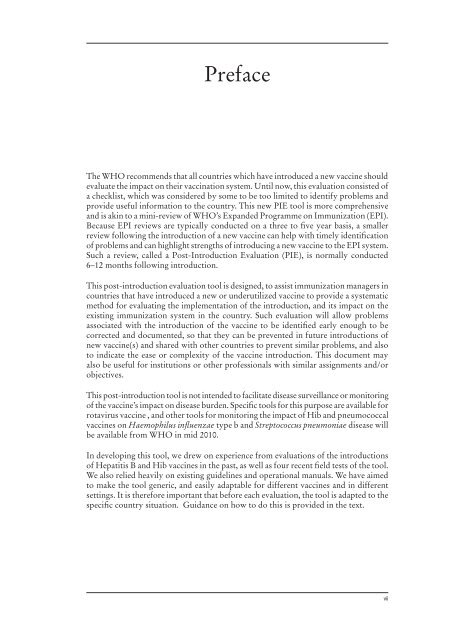New Vaccine Post-Introduction Evaluation - libdoc.who.int - World ...
New Vaccine Post-Introduction Evaluation - libdoc.who.int - World ...
New Vaccine Post-Introduction Evaluation - libdoc.who.int - World ...
You also want an ePaper? Increase the reach of your titles
YUMPU automatically turns print PDFs into web optimized ePapers that Google loves.
Preface<br />
The WHO recommends that all countries which have <strong>int</strong>roduced a new vaccine should<br />
evaluate the impact on their vaccination system. Until now, this evaluation consisted of<br />
a checklist, which was considered by some to be too limited to identify problems and<br />
provide useful information to the country. This new PIE tool is more comprehensive<br />
and is akin to a mini-review of WHO’s Expanded Programme on Immunization (EPI).<br />
Because EPI reviews are typically conducted on a three to five year basis, a smaller<br />
review following the <strong>int</strong>roduction of a new vaccine can help with timely identification<br />
of problems and can highlight strengths of <strong>int</strong>roducing a new vaccine to the EPI system.<br />
Such a review, called a <strong>Post</strong>-<strong>Introduction</strong> <strong>Evaluation</strong> (PIE), is normally conducted<br />
6–12 months following <strong>int</strong>roduction.<br />
This post-<strong>int</strong>roduction evaluation tool is designed, to assist immunization managers in<br />
countries that have <strong>int</strong>roduced a new or underutilized vaccine to provide a systematic<br />
method for evaluating the implementation of the <strong>int</strong>roduction, and its impact on the<br />
existing immunization system in the country. Such evaluation will allow problems<br />
associated with the <strong>int</strong>roduction of the vaccine to be identified early enough to be<br />
corrected and documented, so that they can be prevented in future <strong>int</strong>roductions of<br />
new vaccine(s) and shared with other countries to prevent similar problems, and also<br />
to indicate the ease or complexity of the vaccine <strong>int</strong>roduction. This document may<br />
also be useful for institutions or other professionals with similar assignments and/or<br />
objectives.<br />
This post-<strong>int</strong>roduction tool is not <strong>int</strong>ended to facilitate disease surveillance or monitoring<br />
of the vaccine’s impact on disease burden. Specific tools for this purpose are available for<br />
rotavirus vaccine , and other tools for monitoring the impact of Hib and pneumococcal<br />
vaccines on Haemophilus influenzae type b and Streptococcus pneumoniae disease will<br />
be available from WHO in mid 2010.<br />
In developing this tool, we drew on experience from evaluations of the <strong>int</strong>roductions<br />
of Hepatitis B and Hib vaccines in the past, as well as four recent field tests of the tool.<br />
We also relied heavily on existing guidelines and operational manuals. We have aimed<br />
to make the tool generic, and easily adaptable for different vaccines and in different<br />
settings. It is therefore important that before each evaluation, the tool is adapted to the<br />
specific country situation. Guidance on how to do this is provided in the text.<br />
vii

















